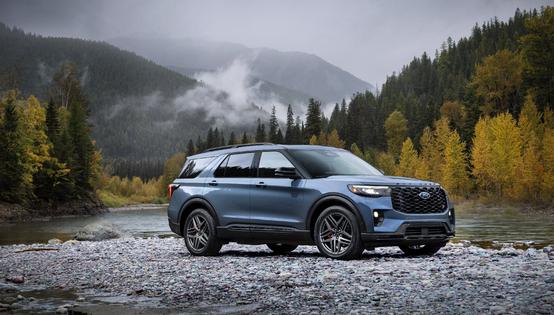Eric's Autos: 2025 Ford Explorer
There are lots of crossovers that look like SUVs but aren't. Few can pull more than 3,500 pounds, and none are built on a truck-type, rear-wheel-drive based layout. That's why they are crossovers rather than SUVs.
Not that there's anything wrong with that. Crossovers are fine for people who want a vehicle that's good in the snow and don't need a vehicle that can pull a heavy load -- but like the looks of an SUV.
For people who want more than just looks, there are SUVs like the Ford Explorer.
What It Is
The Explorer is a midsize SUV -- as distinct from the multitude of midsize crossovers that look like SUVs. It is based on a rear-drive layout and comes standard with RWD rather than front-wheel drive/all-wheel drive (as is true of crossovers made to look like SUVs).
It has room for seven in three rows, though the third row is tight and mainly there for kids and cargo.
The base rear-drive Active trim stickers for $39,785. Full-time four-wheel drive is available as a standalone option. So equipped, the MSRP rises to $41,785. Either way, this trim comes standard with a Class III hitch and a maximum tow rating of 5,300 pounds -- on par with the pulling capability of a midsize truck. A turbocharged 2.3-liter four-cylinder engine that makes 300 horsepower is standard -- another point of difference versus most midsize crossovers that come standard with much less powerful engines. Many do not offer optional engines as powerful as the Ford's standard engine.
The next-up ST-Line stickers for $44,595 (RWD) or $46,595 (4WD) and adds more aggressive visuals as well as some functionals, including a set of 20-inch wheels and short sidewall tires. This trim also gets an upgraded 10-speaker Bang & Olufsen audio system.
The Platinum trim -- $52,100 with rear drive, $54,100 with 4WD -- includes the ST-Line's visual and functional upgrades and adds a twin-panel sunroof, massagers for the front seats, heated second-row captain's chairs, power-folding third row and a 14-speaker B&O sound system. The 4WD version of the Escape can also be equipped with a larger, 3.0-liter turbocharged V6 engine that touts 400 horsepower as part of a $4,615 Platinum Ultimate package.
There is also a high-performance ST variant that comes standard with the 3.0-liter V6 plus a sport-tuned suspension, upgraded brakes and 21-inch wheels with high-performance tires, plus paddles shifters for the transmission and all the ST-Line's cosmetic upgrades. The rear-drive version lists for $54,240; with the optional 4WD system, the price tops out at $56,240.
What's New for 2025
In addition to some exterior styling tweaks to the front and rear clips, the '25 Explorer gets a new, Google-based infotainment system, and all but the base Active trim are available with Ford's BlueCruise hands-free driving tech.
What's Good
-- SUV -- rather than crossover -- capability.
-- Standard engine is very strong; optional engine even stronger.
-- Third row is standard.
What's Not So Good
-- Automatic stop/start "technology" is standard -- along with an array of "driver assistance technology" that ought to be optional -- for those who want to be "assisted."
-- Optional engine is only available in the expensive Platinum and ST trims.
-- Because it is an SUV, the third row is tight for adults.
Under the Hood
The Explorer's standard 2.3-liter turbocharged four touts 300 horsepower and 310 foot-pounds of torque -- output that is on par with what many early 2000s V8s put out -- and that's one reason why the Explorer can pull 5,300 pounds even though it only has a four-cylinder engine. The other reason, of course, is that the Explorer is an SUV and so more ruggedly built. And because it is rear drive rather than front drive.
The little four also touts not-terrible gas mileage -- 20 mpg city, 29 mpg highway. And it can get the nearly 4,800-pound Explorer to 60 mph in seven seconds too.
If that's not quick enough -- and if you can afford it -- the Explorer is available with a 3.0-liter turbo'd V6 that makes 400 horsepower and 415 foot-pounds of torque that knocks about one second off the 0-60 mph time and adds 300 more pounds of maximum towing capacity, which goes up to 5,600 pounds. Impressively, gas mileage goes down hardly at all. Equipped with the larger, 100 horsepower-stronger V6, the Explorer still manages 18 mpg city, 25 mpg highway.
On the Road
As soon as the Explorer moves, it's evident it's an SUV rather than a crossover trying to look like an SUV. This is a good thing -- if you like the planted, heavy (in a good way) authoritative driving feel of an SUV. There's real heft here -- which not only feels good, it is good in that weight is an inherent, built-in safety advantage. This thing feels like you could drive it right through a crossover and come out the other side.
It ought to feel that way given it weighs just shy of 4,800 pounds empty.
That heft is on account of ruggedness -- the heavier-duty, more truck-like underthings -- hence the standard 5,300-pound tow rating.
Another thing to like about this big lug is its small standard engine -- which makes the power (300 horsepower and 310 foot-pounds of torque) of a much larger engine. Put another way, it is not necessary to upgrade to the larger, optional engine -- which is a significant cost savings that does not come at the cost of low towing capability.
The only objectionable thing about the little four is that it sounds little. It is not a bad sound. Just an incongruent one. Imagine the sound of a 250cc single emanating from a big Harley cruiser bike and you get the idea. The optional six corrects that incongruity. It almost sounds like a V8, in fact -- but only when pressed. If you don't press down too much on the accelerator, you just go -- without any incongruent sounds.
At the Curb
The Explorer is 198.8 inches long -- about the same overall size as a current slightly larger-than-midsize sedan such as a Toyota Crown (196.1 inches long overall). But it has room for several more people than a Crown or any other equivalent-size sedan and vastly more room for cargo -- because you have essentially the entire interior space to work with rather than just a trunk (the Crown's has just 15.2 cubic feet while there's 18.2 cubic feet behind the Explorer's third row and the total available space can be opened up to 87.8 cubic feet).
The Explorer also looks like the SUV it is. Or, put another way, it does not try to look like what it isn't, as seems to be the trend among crossovers. But -- unlike any new truck -- it is not all jacked up and so not a climb to get in and out of. This is a major appeal of both SUVs and crossovers relative to today's trucks -- at least to people who are not wanting to have to climb up to get in.
There's still 7.9 inches if ground clearance, though -- and that (plus the optional full-time 4WD system) will get you through the snow and raise you high enough off the ground to drive out into the field, if you need to. There's no low-range transfer case, though -- and no 4WD Low range -- so this Explorer isn't really set up to deal with more than fields and dirt/gravel roads that crossovers can safely ascend.
The Rest
It's nice that you do not have to pay extra for the 4WD system if you don't feel the need -- even in the Platinum and ST trims. On the other hand, if you want to get the six rather than the four, you must buy at least the Platinum trim and then nearly another $5,000 to get it as part of a bundled package that includes other things you may not want -- or want to pay extra for.
The Bottom Line
If you're looking for more than just crossover looks, you might want to look at this SUV.
========
Eric's latest book, "Doomed: Good Cars Gone Wrong!" will be available soon. To find out more about Eric and read his past columns, please visit the Creators Syndicate webpage at www.creators.com.
Copyright 2025 Creators Syndicate, Inc.








Comments